ASM Metals HandBook Vol. 14 - Forming and Forging
Подождите немного. Документ загружается.

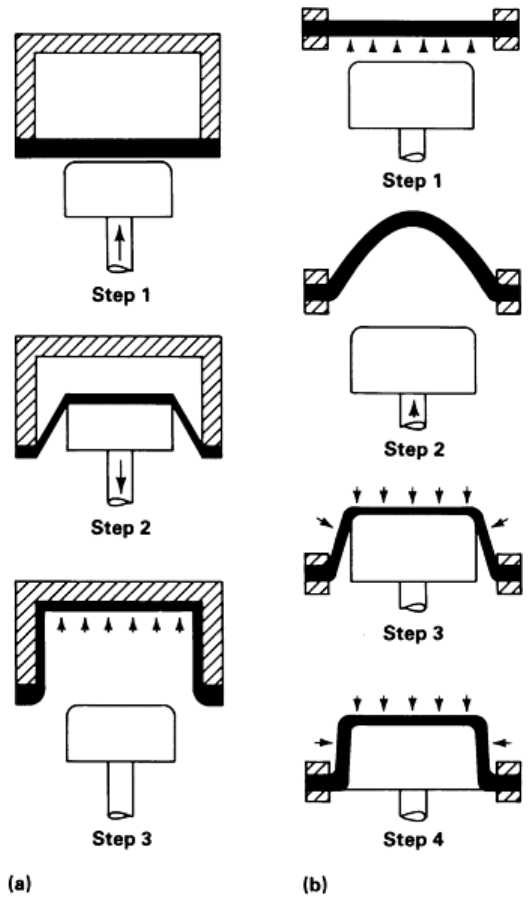
Fig. 12 Examples of thermo-forming methods used for superplastic forming. (a) Plug-
assisted forming into a
female die cavity. (b) Snap-back forming over a male die that is moved up into the sheet
Figure 13 illustrates two other methods that employ a movable die member that aids in prestretching the sheet material
before gas pressure is applied. In this case, the gas pressure is applied from the same side of the sheet as the moving die.
These techniques provide ways of producing different shapes of parts and are effective for controlling the thinning
characteristics of the finished part.
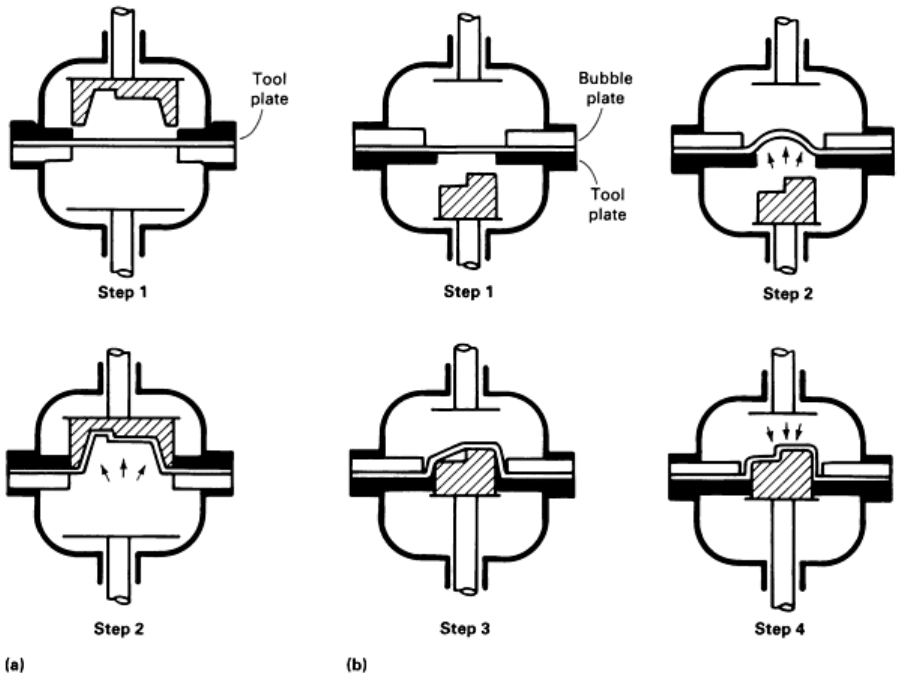
Fig. 13 Thermo-
forming methods that use gas pressure and movable tools to produce parts from superplastic
alloys. (a) Female forming. (b) Male forming
Deep Drawing. Although deep-drawing studies have been conducted with superplastic metals, this process does not
appear to offer many significant advantages in the forming of superplastic materials. Deep drawing depends on strain
hardening to achieve the required formability and to prevent thinning and rupture during forming. Superplastic materials
do not strain harden to any great extent, but they depend on the high strain rate hardening for their forming characteristics,
and this property seems to offer little aid to deep drawing.
The difficulty is that, in order to draw-in the flange, the material in contact with the punch nose, as well as that in the
sidewall, must work harden to carry the increasing stresses required to draw-in increasing amounts of the flange. At
superplastic temperatures, no significant work hardening occurs, and the punch typically pierces the blank, or the blank
fails in the cup walls if the frictional constraint between the punch and the blank is high. However, in studies on the zinc-
aluminum alloy, a maximum draw ratio of 2:1 has been developed under optimized conditions (Ref 31).
A technique that tends to improve the drawability of superplastic alloys is discussed in Ref 32. This method (Fig. 14) uses
a punch cooled to a temperature below that of the forming blank, while the hold-down tooling is maintained at the
forming temperature. It was demonstrated that this differential temperature technique permitted an increase in the limiting
draw ratio from less than 2.4:1 for isothermal conditions to more than 3.75:1 for the differential temperature method. The
thinning characteristics for this process are also shown in Fig. 14. Slight thinning can be seen to occur over the (cold)
punch nose, and substantial thinning is seen in the material adjacent to the punch. The extent of the thinning in the
material adjacent to the punch depends on the blank hold-down load, but increases with increasing blank diameter (draw
ratio) and decreasing punch speed. Because ironing was not used in these forming tests, thickness increases were
observed at the greater distances from the pole of the cup where substantial draw-in of the material occurred.
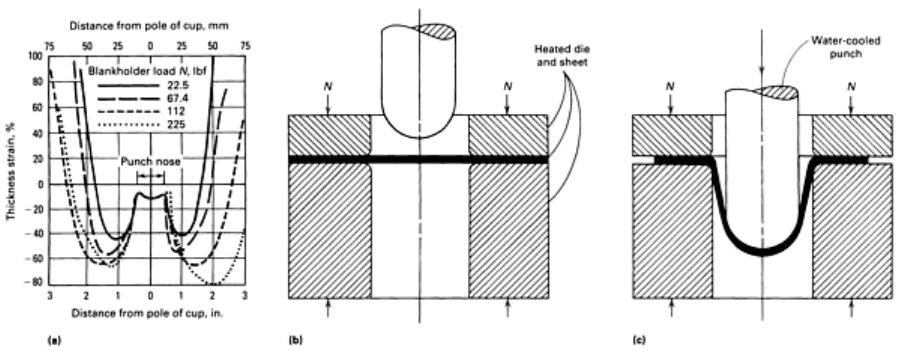
Fig. 14
Punch setup for deep drawing a superplastic sheet. (a) Plot showing thinning characteristics of a 59.9
mm (2.36 in.) diam Zn-21Al-1Cu-0.1Mg heated sheet that was formed using the 160 mm (6.3 in.) diam water-
cooled punch setup illustrated in (b) and (c). N,
blankholder load. Both the die and zinc alloy sheet were heated
to 230 °C (445 °F). Punch speed was 33.0 mm/min (1.3 in./min), and maximum punch load was 2150 N
(483
lbf). Draw ratio was 3.75. See text for discussion.
Another concept evaluated to explore the deep-drawing capability is discussed in Ref 33. This method uses high-pressure
oil around a blank periphery to aid in the drawing. It is actually a combined extrusion and drawing process. In this study,
a tin-lead eutectic was used, which permitted processing at ambient temperature. Good control of wall thickness was
achieved, but the applicability of the process to alloys requiring high temperatures has yet to be demonstrated.
SPF/DB Processes. Recent developments have demonstrated that a number of unique processes are available if
joining methods, such as diffusion bonding, can be combined with superplastic forming; these processes are generally
referred to as SPF/DB processes (Ref 22, 34, 35). Although diffusion bonding is not a sheet metal process, it
complements and enhances superplastic forming to such an extent that the two processes must be discussed together.
The SPF/DB processes have evolved as natural combinations of the SPF and DB processes because the process
temperature requirements of both are similar. The low flow properties characteristic of the superplastic alloys aid the DB
pressure requirements, and it has been found that many superplastic alloys can be diffusion bonded under pressures in the
same low range as that used for SPF processing (that is, of the order of 2100 to 3400 kPa, or 300 to 500 psi). The SPF
method used with SPF/DB to date is that of blow forming.
The resulting SPF/DB process consists of the following variations:
• Forming of a single sheet onto pre-placed details, followed by diffusion bonding (Fig. 15)
•
Diffusion bonding of two sheets at selected locations, followed by the forming of one or both into a die
(Fig. 16); the reverse sequence can also be used
•
Diffusion bonding of three or more sheets at selected locations under gas pressure, followed by
expansion under internal gas pressure, which forms the outer two shee
ts into a die; in the process, the
center sheet(s) is stretched into a core configuration (Fig. 17)
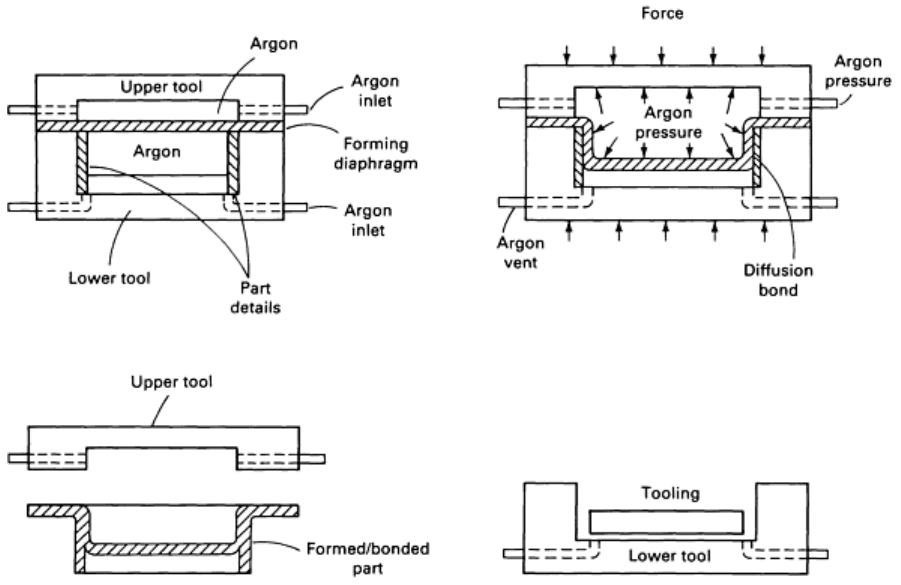
Fig. 15
Cross section of the SPF process combined with diffusion bonding (SPF/DB). The process shown utilizes
pre-placed details to which the superplastic sheet is bonded.
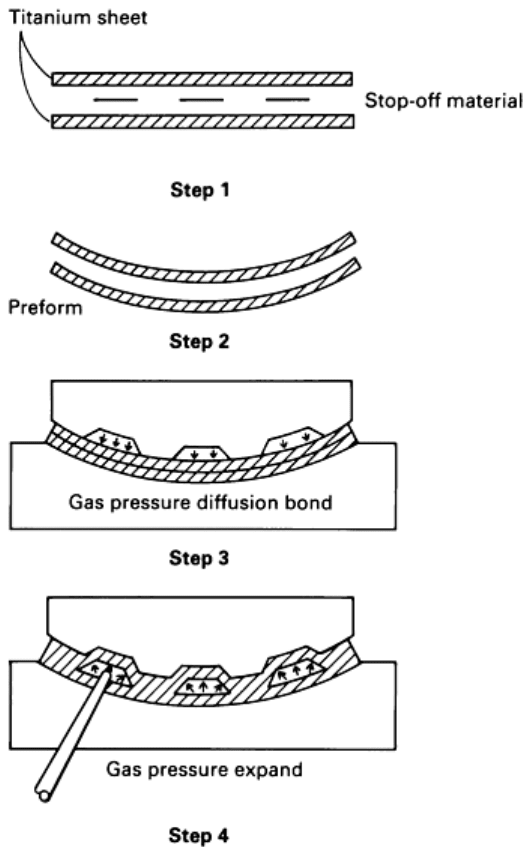
Fig. 16 Operations required for joining two sheets of superplastic alloy using the SPF/DB process.
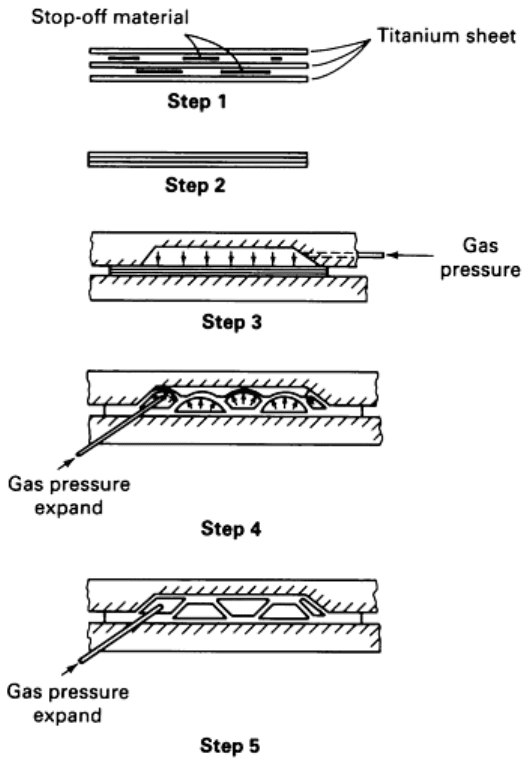
Fig. 17 Operations required for joining three sheets of superplastic alloy using the SPF/DB process
A few techniques have been used to develop diffusion bonds in predetermined local areas. One of these involves the use
of a parting agent, or stop-off material, between the sheets in the local areas where no bonding is desired. Suitable stop-
off materials may depend on the alloy being bonded and the temperature being used. For example, yttria or boron nitride
has been successfully employed to stop-off titanium alloys processed to temperatures of at least 930 °C (1705 °F). Such
stop-off materials can be suspended in an appropriate binder, such as acrylic. After a DB operation, the area of the stop-
off pattern is not bonded, and gas can be applied internally along this pattern, thus causing the external sheets to be
separated and formed by expanding into a surrounding die.
A variation of the above method involves the use of a minimum of four sheets to make a sandwich panel. The external
(for example, skin) sheets are expanded, the inner two sheets are then bonded (or welded) to define the core structure, and
finally the core is expanded to bond with the external sheets and to complete formation of the sandwich structure. This
sequence is shown in Fig. 18.
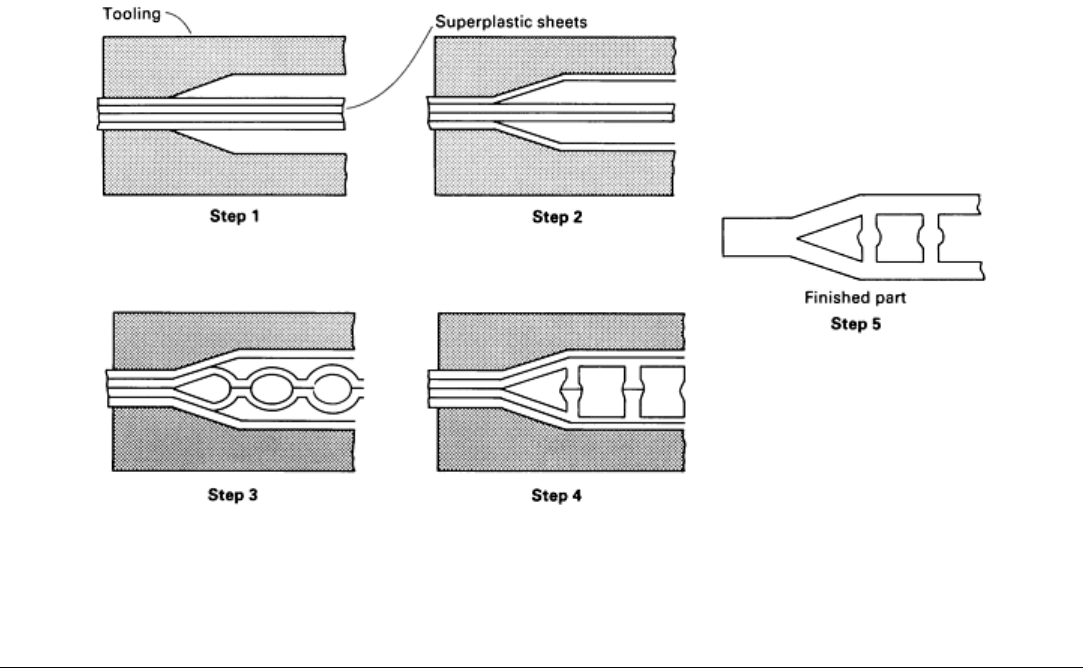
Fig. 18 Example of a four-
sheet SPF/DB process in which the outer sheets are formed first and the center
sheets are then formed and bonded to the outer two sheets.
References cited in this section
3. K.A. Padmanabhan and G.T. Davies, Superplasticity, Springer-Verlag, 1980
22.
C.H. Hamilton, Formability: Analysis, Modeling, and Experimentation, S.S. Hecker, A.K. Ghosh,
and H.L.
Gegel, Ed., The Metallurgical Society, 1977
23.
O.W. Davis, C.F. Osborne, and G.J. Brooks, Met. Eng. Quart., Nov 1973, p 5
24.
R. Pearce, Mod. Met., April 1986, p 188
25.
F. Jovane, Int. J. Mech. Sci., Vol 10, 1968, p 403
26.
G.C. Cornfield and R.H. Johnson, Int. J. Mech. Sci., Vol 12, 1970, p 479
27.
A.K. Ghosh and C.H. Hamilton, Process Modeling: Fundamentals and Applications to Metals,
American
Society for Metals, 1979, p 303
28.
C.D. Ingelbrecht, J. Mater. Sci. Lett., Vol 4, 1985, p 1021
29.
C.H. Hamilton and G.W. Stacher, Met. Prog., March 1976, p 34
30.
W. Johnson, T.Y.M. Al-Naib, and J.L. Duncan, J. Inst. Met., Vol 100, 1972, p 45
31.
T. Oshita and H. Takei, J. Jpn. Inst. Met., Vol 36, 1973, p 1081
32.
R. Hawkins and J.A. Belk, Met. Technol., Nov 1976, p 516
33.
T.Y.M. Al-Naib and J.L. Duncan, Int. J. Mech. Sci., Vol 12, 1970, p 463
34.
B.W. Kim, and A. Arieli, Paper 8201-
076, presented at the ASM Metals Congress, St. Louis, MO, ASM
Metals/Materials Technology Series, American Society for Metals, 1982
35.
J.R. Williamson, Diffusion Bonding in SPF/DB, in Proceedings of the American Welding Society
(Las
Vegas, NV), 1982

Superplastic Sheet Forming
C.H. Hamilton, Washington State University; A.K. Ghosh, Rockwell International
Forming Equipment and Tooling
The forming of superplastic sheet materials involves methods that are generally different from those used in other, more
conventional sheet forming processes. The forming environmental conditions are also different. Therefore, the equipment
and tooling used are generally different.
Forming Equipment. For the blow forming and vacuum forming methods, there is a need to provide constraint to the
forming tools in order to counteract the forming gas pressure. In addition, a seal is generally required at the interface
between the sheet and the tool around the periphery in order to prevent leakage of the gas pressure. A press is typically
used to meet these requirements. Hydraulic presses and mechanical clamping systems have been used, and each has
advantages and disadvantages. The hydraulic press can be loaded and unloaded fairly rapidly, but it requires a significant
capital investment. The mechanical clamping systems are much less expensive, but are more cumbersome to load and
unload. Recently, robotic systems have been coupled with a hydraulic press to aid the loading and unloading, and this
type of advanced system is especially beneficial for high-temperature forming operations such as titanium alloy SPF
processing.
The hydraulic presses used include both single-action and multiple-action systems (Ref 22, 23, 30). In the single-action
press, the press applies the constraining pressure only. In the multiple-action press, the press can also move dies into the
forming sheet and effectively aid in the control of the thinning gradients (Fig. 12 and 13).
The heating system used must be tailored to the temperature required and the allowable thermal gradients. The most
common heat source is electrical heating, in which resistance heating elements are embedded in ceramic or metal pressure
plates placed between the tooling and the press platens. This allows for good control of the temperature and provides a
clean source of energy. The heating platens can be arranged in sections of heating elements, and each section can be
controlled by independent temperature controllers to minimize thermal gradients in the forming die assembly. Significant
thermal gradients can lead to excessive thinning or rupture of the sheet during forming.
Tooling Materials. The tooling used in the SPF process is generally heated to the forming temperature, and it is
subjected to internal gas pressure and pressing clamping loads. The internal gas pressure is typically less than about 3400
kPa (500 psi), and this is usually not the critical design factor for SPF tools. More important are the clamping loads and
thermal stresses encountered during heat-up and cool-down and the environmental conditions. The thermal stresses can
cause permanent distortions in the die, and this is controlled by selection of a material that has good strength and creep
resistance at the forming temperature. Slow heating and cooling of the tooling can reduce the thermal stresses. Materials
with a low coefficient of thermal expansion and those that do not undergo a phase transformation during heating and
cooling are preferred for the high-temperature SPF processes.
The environmental conditions can be severe for the forming of high-temperature materials, such as the titanium alloys,
iron alloys, nickel alloys, and other high-temperature metals. Oxidation can alter the surface condition of the tooling, thus
affecting the surface quality of the SPF part produced and eventually affecting the dimensional characteristics.
Another important environmental factor is the compatibility between the superplastic sheet and the tooling, and the
compatibility of these with the stop-off materials that may be used. Interdiffusion at the tooling/sheet interface can result
in the degradation of both of these materials. Reactive metals, such as titanium alloys, are especially prone to this type of
problem. Tooling materials that have been found to be successful with titanium alloys are the Fe-22Cr-4Ni-9Mn alloy and
similar materials. Parting, or stop-off, agents are also helpful in minimizing the interaction, and materials such as boron
nitride and yttrium oxide have been successfully used. Generally, materials with a low solid solubility in the sheet are
good candidates for compatibility.
A variety of materials have been used for SPF tooling, including metals and alloys, ceramics, and graphite (Ref 36). Metal
tools are preferred for large production quantities, such as 100 parts or more. Graphite tools are suitable for about 100
parts, and they are readily hand worked, although there is a problem with shop cleanliness with graphite. Ceramics can be
cast into the desired shape and are therefore inexpensive for a variety of large parts. Because the ceramic is subject to

cracking and rapid degradation, it requires frequent repair. Ceramic tools are considered for small production quantities,
usually less than about 10 parts.
References cited in this section
22.
C.H. Hamilton, Formability: Analysis, Modeling, and Experimentation, S.S. He
cker, A.K. Ghosh, and H.L.
Gegel, Ed., The Metallurgical Society, 1977
23.
O.W. Davis, C.F. Osborne, and G.J. Brooks, Met. Eng. Quart., Nov 1973, p 5
30.
W. Johnson, T.Y.M. Al-Naib, and J.L. Duncan, J. Inst. Met., Vol 100, 1972, p 45
36.
J.F. Hubert, Tool. Prod., Vol 42, 1977, p 74
Superplastic Sheet Forming
C.H. Hamilton, Washington State University; A.K. Ghosh, Rockwell International
Thinning Characteristics
To take advantage of the very high elongations possible with superplastic metals, it is necessary to accept the
accompanying significant thinning in the sheet material. This thinning is a natural consequence of the deformation
conditions. For superplastic deformation, elastic strains are negligible; therefore, constancy of volume can be assumed.
From this consideration, the sum of the plastic strains is 0, and tensile strain in one direction must be balanced by
compressive (negative) strains in another. The strains are:
1
+
2
+
3
= 0
(Eq 8)
where is the strain, and the subscripts indicate the principal directions. For example, in a sheet forming operation under
plane-strain conditions,
2
= 0 and
3
= -
1
. In this case, the thinning strain (for example,
3
) is equal and opposite to the
longitudinal tensile strain, and the thinning will therefore match the tensile deformation. For large tensile strains, the
thinning will be correspondingly large. Accordingly, as the thinning increases, the tendency to develop thinning gradients
also increases.
Although the superplastic materials are effective in resisting the necking process, they nonetheless do neck (in relation to
the m value), and thinning gradients do develop. Therefore, in the design and processing of SPF parts, it is important that
the thinning be understood and considered.
Uniaxial Tensile Test. It has been shown that superplastic deformation occurs when m is large and that under these
conditions the deformation process is predominately postuniform, in contrast to conventional metal tensile behavior. In
most cases, virtually all deformation is nonuniform, and the issue in the tensile behavior is the extent of this
nonuniformity. The thinning in the tensile specimen can be assumed to be the result of a preexisting inhomogeneity,
which can grow under the imposed deformation (Ref 37, 38).
The rate of thinning in the tensile specimen is therefore determined not only by the size of the inhomogeneity but also by
the m value. This has been demonstrated analytically for an idealized tensile specimen (Fig. 19) containing a geometric
inhomogeneity, f (for example, a machining defect) (Ref 9). This analysis follows the strain development both inside and
outside the inhomogeneity, assuming that the applied load is fully transferred along the length of the specimen and that
the material obeys the following constitutive equation:
= K
n
m
(Eq 9)
where n is the strain-hardening exponent (n is small in this case). The results of calculations using Eq 9 are shown in Fig.
20, in which the strain in the inhomogeneity is graphed as a function of the strain outside the inhomogeneity for a number
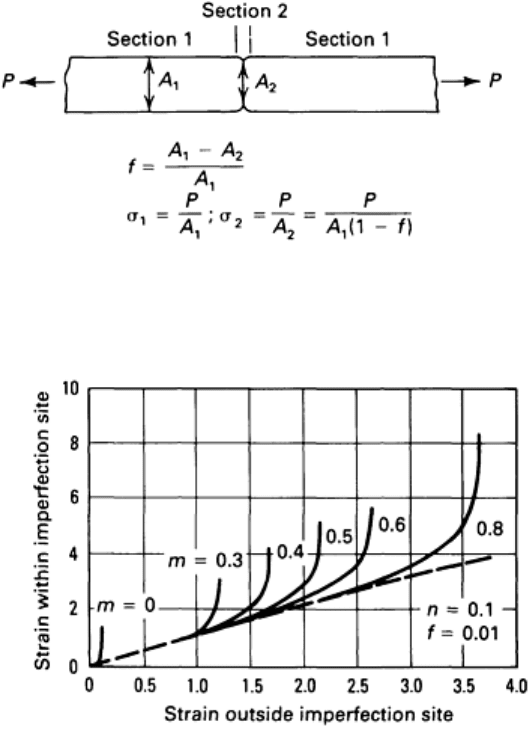
of different m values. The extent of the thinning in the tensile specimen is shown to be strongly related to the m value,
although thinning gradients will develop at all m values if the strain is sufficiently large. It will be seen that this is also the
case for sheet forming in which the inhomogeneity is caused by stress gradients resulting from the part geometry and tool
interactions. The inhomogeneities in tensile specimens have also been found to relate to the m value (Ref 39), as shown in
Fig. 21 for the Zn-22Al eutectoid alloy. In Fig. 21, the results are presented for the same alloy tested at different strain
rates, for which the m values are known to differ.
Fig. 19 Geometric inhomogeneity, f, in a tensile specimen
Fig. 20
Calculated strains inside and outside an inhomogeneity in a tensile specimen, such as that shown in
Fig. 19, for various m values
